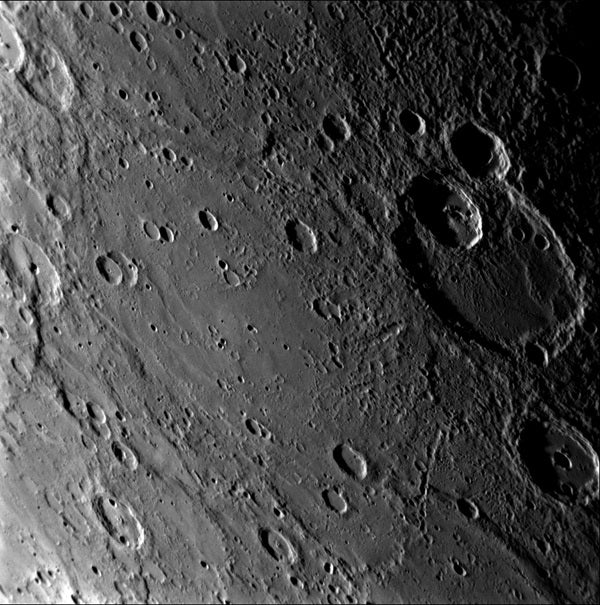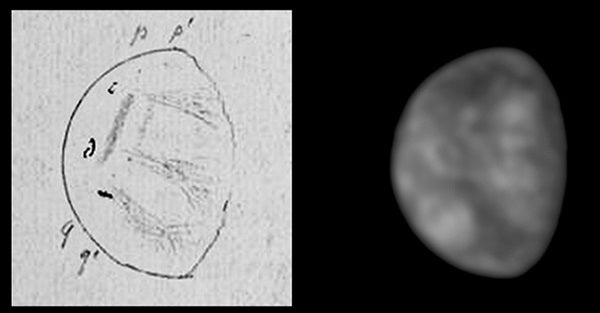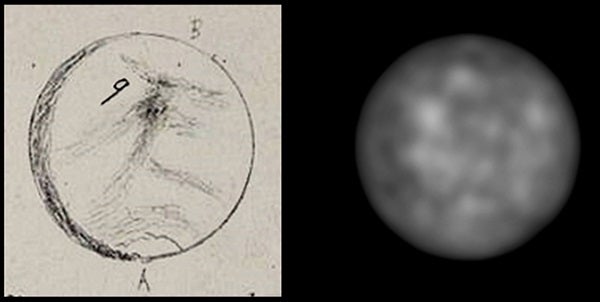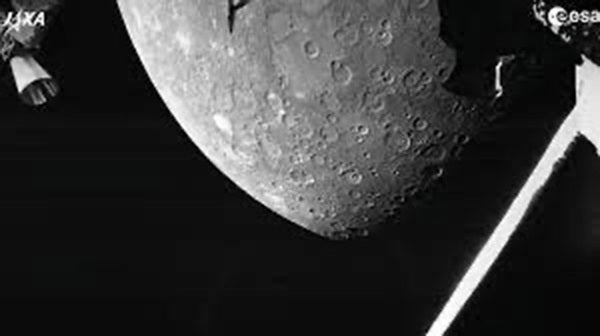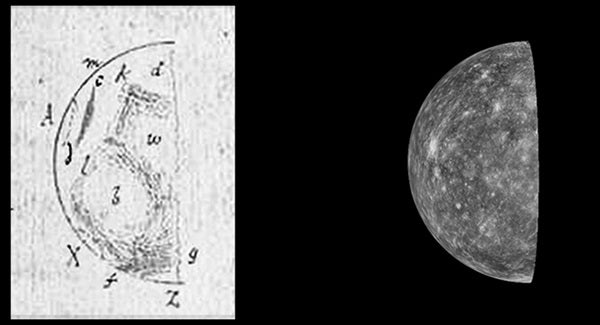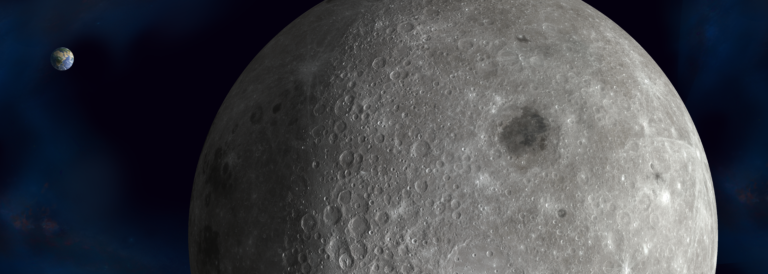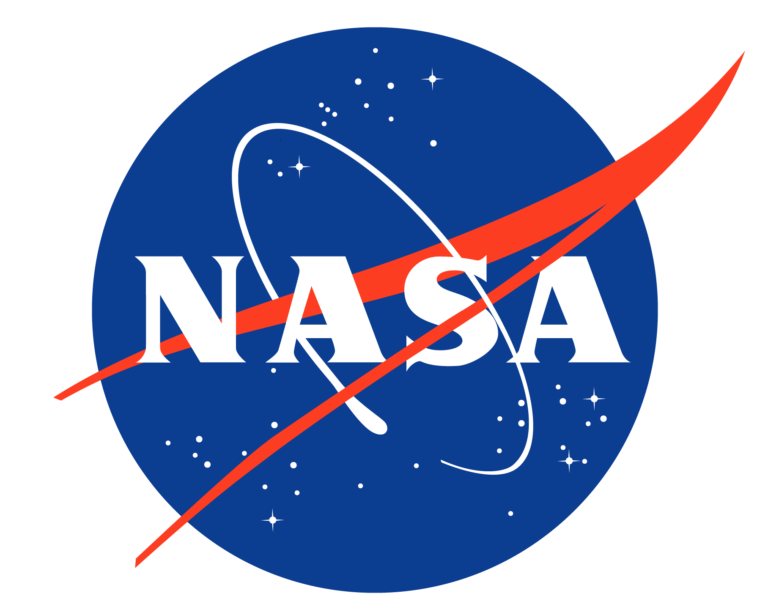Only intermittently visible in the twilight before sunrise or after sunset, Mercury is the smallest and least conspicuous of the naked-eye planets. However, its surface is the second easiest (after Mars) to examine with a telescope. Named for the swift-footed messenger of the gods of Olympus, diminutive Mercury has recently attracted outsize attention. On Oct. 1, 2021, the joint European-Japanese BepiColombo spacecraft made its first of six flybys of the tiny planet before it settles into orbit around Mercury in 2025.
The future of Mercury exploration is surely bright. But for a long time, we knew very little about the planet. And what little we did know was mostly wrong.
Some 140 years ago, Italian astronomer Giovanni Virginio Schiaparelli launched an investigation of Mercury that still stands as one of the most heroic endeavors of the visual telescopic era. That valiant effort deserves remembrance this April, as the planet swings to its most favorable evening elongation of the year — once more garnering the attention of those seeking a unique observing challenge. And, as an added bonus, Mercury offers another pleasant surprise this time around. (But more on that later.)
Schiaparelli targets Mercury
In the early 1880s, when Schiaparelli began his study of Mercury, he was already famous for his work mapping Mars. So, using the 9-inch Merz refractor at Brera Astronomical Observatory in Milan, he decided to extend his survey of the planets inward. Venus, as usual, offered little more than a nearly featureless disk. But Mercury seemed promising.
At the time, the early results of 19th-century German astronomer J.H. Schröter, who utilized a large reflector, still reigned. Noticing a blunting of the southern cusp of Mercury on several nights, Schröter deduced a satisfyingly Earth-like rotation period of about 24 hours. But his observations had been made during the short twilight periods, when he was forced to view the planet through the densest layers of Earth’s atmosphere. Schiaparelli’s telescope, meanwhile, was equipped with setting circles (by which he could pinpoint objects using their right ascensions and declinations) and a clock drive, allowing him to follow Mercury for hours. He decided to try observing the planet in broad daylight. Because Mercury was higher in the sky then, it would reward sustained inspection.
Schiaparelli’s initial tests of his technique in June 1881 were promising. That led to a sustained effort that began at the end of January 1882. Over the course of seven years, Schiaparelli made hundreds of observations of Mercury, as well as 150 drawings, which are preserved in the archives of Brera Observatory.
The air over Milan was turbulent during the summer, but in winter, it was often “pure and calm.” That meant observations at any time of day were feasible. With his usual magnification of 200x, Schiaparelli scrutinized the tantalizing pale rose orb, which appeared through his telescope a little smaller than the Moon does with the naked eye. Markings on Mercury were almost always present, in the form of “extremely delicate streaks.” But they were of such low contrast that they disappeared whenever haze or a layer of cirrus clouds intervened.
Schiaparelli made heroic efforts to follow Mercury to only 3½° west of the Sun, as the planet approached superior conjunction in August 1882 (an endeavor he later admitted was damaging to his eyesight). His sketch (left) with CM = 351.9°, was made Aug. 12, and shows a dark patch he called q and thought he had recorded at previous elongations west of the Sun. The blurred WinJUPOS image (right) shows the same face of the planet, in which a triad of bright spots can be made out that show up more clearly in the top “Full Moon” of Mercury as the rayed craters Ellington, Debussy, and Kuiper.
Go figure
Schiaparelli began to observe Mercury around the time of its greatest elongation east of the Sun on Feb. 6, 1882, corresponding to the planet’s appearance as an evening star. On that date, he succeeded in making out a “large system of spots” on the nearly dichotomized disk. These spots, he noted, oddly combined to form the shape of the numeral 5. He denoted each part of the number with the letters w, a, b, k, and i. That figure 5 made a profound impression on Schiaparelli, and it was to haunt him whenever Mercury ran east of the Sun (as it did that May, when he again made out the 5). On the other hand, whenever the planet ran west of the Sun — becoming a morning star — Schiaparelli seemed to see the same prominent dark patch, which he labeled q.
He made his bravest series of observations that August, when he followed the planet’s tiny gibbous disk to within only 3.5° west of the Sun. This feat of observational daring, he later admitted, proved extremely damaging to his retinas. He found “the planet appears almost perfectly round, with the light only a little less than uniform; but despite the fact that the apparent diameter was reduced to 4″ or 5″ across, the positions of the observable markings could be judged with greater certainty than at other times.” This time, he seemed to recover the dark patch q. In September, the next time Mercury ran east of the Sun, he once more discovered the 5. Schiaparelli’s ideas were now starting to gel, and he ultimately believed the timely appearances of the observed markings confirmed Mercury’s orbital period and rotational period were the same: 88 Earth days.
On Oct. 20, 1882, he wrote to his close friend and confidant François Terby, an amateur astronomer in Louvain, Belgium. Schiaparelli requested that, if he should die before he could publish, Terby should make Schiaparelli’s work known “so that this beautiful result will not be lost to science.” An avid classicist, Schiaparelli communicated his result to Terby in Latin verses, which read (translated):
Cyllenius [Mercury], turning on its axis after the manner of Cynthia [the Moon], Eternal night sustains, and also day: The one face is burned by perpetual heat, The other part, hidden, is deprived of the sun….
More prosaically stated, one hemisphere of Mercury always faces the Sun, while the other always faces away — just like the Moon with respect to Earth. However, as in the case of the Moon, Mercury would appear to wobble (or librate) around the fixed line between it and the Sun. This effect was bound to be rather considerable, given the eccentricity of Mercury’s orbit, and it provided Schiaparelli with some cover from the fact that he found the positions of his spots were quite variable over time. Yet even libration could not account for all the observed variation. In the end, Schiaparelli was forced to invoke the existence of a substantial atmosphere around the tiny planet, and even sometimes brilliant white clouds.
Despite making up his mind about Mercury’s 88-day rotation and revolution period, Schiaparelli still held back from publication until he could confirm his results with a larger telescope. He eventually went on to use a 19-inch Merz-Repshold refractor, which was installed at Brera in 1886. But the observations with this larger scope did not prove decisively better than those made with the smaller Merz. At last, in late 1889, Schiaparelli put forth a memoir, in which he summarized his observations and published his famous planisphere. In December, he made a rare trip outside Milan to lecture at the Quirinal Palace in Rome to a popular audience that included the king and queen of Italy. During the lecture, Schiaparelli provocatively suggested the possibility that liquid water — and life itself — might flourish in the “twilight zone” between the perpetually sunlit and the perpetually night-shaded sides of Mercury.
Schiaparelli lived until 1910, remaining sure of his results to the end. A host of later observers lined up to confirm his results, too. Preeminent above the rest was Greek-French astronomer E.M. Antoniadi, whose long study of Mercury in the 1920s with the 33-inch refractor at Meudon Observatory near Paris seemed to definitively confirm Schiaparelli’s map, his rotation period, and his clouds. Researchers came to regard Mercury’s 88-day rotation period as one of the best-established facts in all of planetary science. And yet it was all an illusion.
Dial it back
To astronomers’ great surprise — and even consternation — in 1965, radio astronomers established that Mercury’s rotation period was really 58.65 days, or two-thirds its orbital period. At once, it was asked how Schiaparelli and his followers could have gotten it so wrong.
One factor, identified at the time by astronomers Dale P. Cruikshank and Clark R. Chapman, involved a curious “stroboscopic effect.” This is where, for several years in succession, the same side of Mercury tends to present itself during the planet’s most favorable elongations (in the spring for evening observations and in the autumn for morning observations). This effect causes Mercury’s surface features to appear rather static, making it difficult for observers to recognize how the markings change due to rotation. However, because Schiaparelli observed during periods other than spring and autumn, this explanation doesn’t completely suffice.
Instead, it seems that because Mercury’s markings are so delicate and vague in outline, subjective — that is, perception-based — factors came into play. Once an observer establishes a definite expectation, they become predisposed to seeing the expected result.
This reinforces and refines their expectations until, finally, they see an exact and detailed — but ultimately fictitious — picture. It seems Schiaparelli succumbed to such autosuggestion, falling under the spell of his own preconceptions and unable to help but fixate on Mercury’s supposed number 5.
The mental trap that snared Schiaparelli was set with his first drawing of the numeral 5 on Feb. 6, 1882. And here’s the pleasant surprise mentioned at the beginning of the article: During this April’s favorable evening apparition on the 23rd, Mercury will display almost exactly the same face under conditions nearly identical to those Schiaparelli experienced Feb. 6, 1882.
Be sure to take a look. What do you see?
What Schiaparelli saw
Throughout this piece, we have revisited Schiaparelli’s historical observations of Mercury by comparing his series of drawings with CCD images and WinJUPOS simulations. As might be expected, there are a lot of figure 5s. Some of Schiaparelli’s drawings are quite accurate. But in other cases, there is so little resemblance between modern images and what he described that one has to wonder just what he thought he was seeing.
A Schiaparelli challenge
In April 2022, Mercury comes to its most favorable evening apparition of the year (for Northern Hemisphere observers), advantageously placed for naked-eye and telescopic observers alike. After superior conjunction on April 2, Mercury increases its separation from the Sun, and by mid-April, it is easily visible to the naked eye. The world reaches its greatest elongation east of the Sun on April 29, when it passes only 1.5° south of the Pleiades (M45). On May 2, a thin crescent Moon joins the group. Thereafter, Mercury rapidly drops toward the Sun as it heads toward inferior conjunction on May 21.
About a week before it reaches greatest elongation, Mercury will present to telescopic observers nearly the same part of the planet that was in view when Schiaparelli began his legendary study of the world in 1882. A potentially perfect night for trying to emulate the great Italian astronomer’s view is April 23. At that time, the planet’s disk will be 6.8″ wide, 56 percent illuminated, and the longitude of the central meridian (CM) will stand at 85° (as compared to 7.0″ wide, 53 percent illuminated, and a CM at 86° on Feb. 6, 1882). Observers equipped with telescopes in the 6- to 10-inch range will want to travel back in time and take turns at the eyepiece with Schiaparelli himself in scrutinizing this once-mysterious planet.
In addition to searching for the subtle figure 5, you should also look for the bright spot Kuiper, which pre-spacecraft era observers like Schiaparelli recorded as a brilliant patch and identified as a cloud.
During its flyby of Mercury in March 1974, Mariner 10 discovered Kuiper is in reality a fresh, 38.5-mile-wide (62 kilometers) impact crater surrounded by a system of bright ejecta rays.
Happy sleuthing! — Frank Melillo, W.S.

